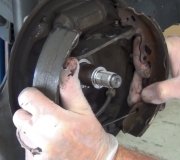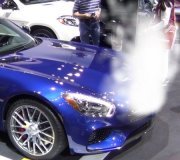Wow. You noticed an observation only real experienced mechanics know to look for. There's two or three different switches that turn on the red "Brake" light, and when you see it get brighter, it means that switch isn't the one causing the problem. In this case the light is not on due to a parking brake that is failing to fully release. That leaves the pressure-differential switch, or, if your vehicle uses one, the fluid level switch in the master cylinder reservoir.
First check the fluid level. If it's low, add just enough to turn the light off. Don't fill it to the top unless the front disc pads are fairly new. Replacing the pads means pushing the pistons back into the calipers, and that sends all that brake fluid back up to the reservoir. If it was filled previously, all that fluid will spill over and make a mess. You can simply unplug the level sensor to see if the warning light goes out. If it does, that's all the further you have to look for that problem.
Based on the fact you don't have a satisfactory pedal yet, it is almost certain there is still air in the line to the rear, and the pressure-differential switch is tripped. To verify that, follow the two metal lines from the master cylinder down to the combination valve right under it on the frame rail. Unplug the connector right in the middle of it. If the light goes off, that switch is stuck. It turns on when unequal pressures build up in the front and rear hydraulic systems, as in when there's a leak or air in one part. On Fords that switch can be REAL frustrating to get it centered and turned off again. On GMs and Chryslers that switch is spring-loaded, but they often stick once they've been tripped. A good hard jab on the brake pedal usually pops them free, then they'll center themselves and turn off.
If the master cylinder ran empty while you were replacing the wheel cylinder, that entire line will have to be bled. Watch for clear, new fluid coming out of the bleeder screw. To prevent that next time, use a stick between the seat and brake pedal to hold the pedal down about an inch. No fluid will run out of the master cylinder while a hydraulic system is open. Later, remove the stick and just let the wheel gravity-bleed for a few seconds, and you're done.
Monday, February 16th, 2015 AT 12:50 PM



